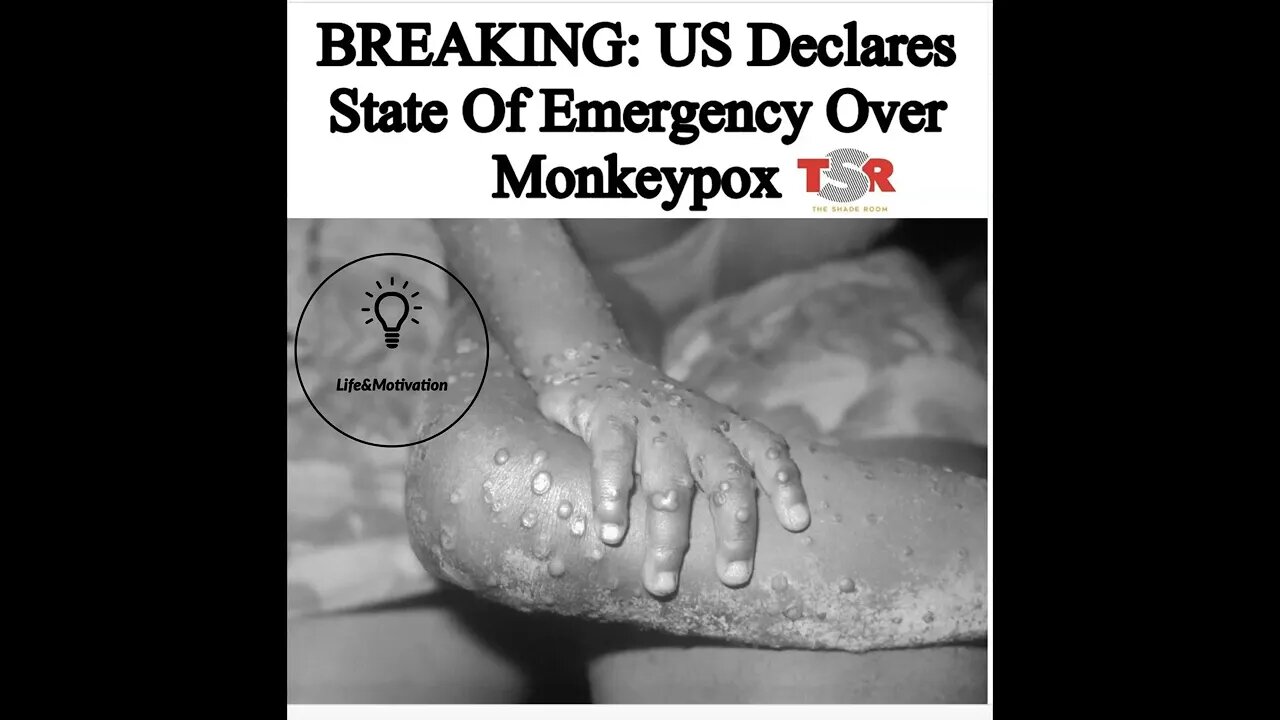Premium Only Content

MONKEYPOX 😱 US Declares State Of Emergency Over MonkeyPox Virus
MONKEYPOX 😱 US Declares State Of Emergency Over MonkeyPox Virus
The Biden administration has declared a state of emergency due to monkeypox. The illness has infected over 6,600 people in the United States.
What is Monkeypox?
Monkeypox got its name in 1958, when it was detected in several laboratory apes. It is a zoonotic viral disease, which means it can be transmitted from animals to humans. It can also pass from human to human.
Human monkeypox was first identified in 1970 in the Democratic Republic of the Congo (DRC) in a 9-month-old boy, in a region where smallpox (a close relative) had been eliminated in 1968.
Symptoms are similar to those seen, in the past, in smallpox patients, but it is clinically less severe (smallpox was eradicated worldwide in 1980). In 2003, the first Monkeypox outbreak outside Africa was reported in the United States and was linked to contact with infected pet prairie dogs.
Despite the name, most of the animals susceptible to contracting the disease, and then infecting people, are rodents, such as Gambian giant rats, dormice, or tree squirrels.
Where is it typically found?
Monkeypox is most found in the rain forests of central and western Africa, where animals that can carry the virus are native, and the disease is endemic. In these countries, it is increasingly appearing in urban areas.
On occasion, it can also be found elsewhere, in people who could have been infected after visiting these countries.
What are the symptoms?
Symptoms usually include fever, severe headache, muscle aches, back pain, low energy, swollen lymph nodes, and skin rashes or lesions.
The rash usually begins on the first or third day of the onset of fever. The lesions may be flat or slightly raised, filled with clear or yellowish fluid, then crust over, dry up, and fall off.
The number of lesions varies, from a few to several thousand. The rash tends to appear on the face, the palms of the hands, and the soles of the feet. They can also be found in the mouth, genitals, and eyes.
Can people die from monkeypox?
In most cases, the symptoms of Monkeypox go away on their own within a few weeks but, in between three and six per cent of cases reported in countries where it is endemic, it can lead to medical complications and even death. New-born babies, children, and people with immune system deficiencies may be at risk of more severe symptoms and death from the disease.
In severe cases, symptoms include skin infections, pneumonia, confusion, and eye infections that can lead to vision loss.
Many of the fatal cases are children or people who may have other health conditions.
How is monkeypox transmitted from animals to humans?
The virus can be spread to people when they come into physical contact with infected animals, which include rodents and primates.
The risk of contracting it from animals can be reduced by avoiding unprotected contact with wild animals, especially those that are sick or dead (including contact with their flesh and blood).
It is crucial to stress that any food containing meat or animal parts should be cooked, especially in countries where Monkeypox is endemic.
How is it spread from person to person?
The virus is spread through physical contact with someone who has symptoms. Rashes, body fluids (such as fluids, pus, or blood from skin lesions), and scabs are particularly infectious.
Ulcers, lesions or sores can also be infectious since the virus can be spread through saliva. Contact with objects that have been in contact with the infected person - such as clothing, bedding, towels - or objects such as eating utensils can also represent a source of infection.
People who have the disease are contagious while they have symptoms (usually within the first two to four weeks). It is not clear whether or not people who are asymptomatic can transmit the disease.
Who is at risk of getting it?
Anyone who comes into physical contact with someone with symptoms or an infected animal, is at increased risk of infection.
Those who live with infected people have a high risk of infection. Health workers, by the very nature of their job, are at risk of exposure.
Children are often more likely to have severe symptoms than teens and adults.
The virus can also be transmitted from a pregnant woman to the foetus through the placenta, or through contact of an infected parent with the child, during or after delivery, through skin-to-skin contact.
Is there any treatment?
Symptoms often go away on their own without the need for treatment. It is important to care for the rash by letting it dry if possible or cover it with a moist bandage if necessary to protect the area.
Avoid touching any eye or mouth sores. Mouthwashes and eye drops can be used as long as products containing cortisone are avoided.
#Monkeypox
-
 1:23:50
1:23:50
Russell Brand
5 hours agoAI Visions, War Deals, and the Next Big Lockdown? – SF544
116K18 -
 1:18:31
1:18:31
vivafrei
6 hours agoCanadian Liberal Leadership Race TO THE BOTTOM! Florida Prosecutor Claims SELF DEFENSE? & MORE!
55.4K34 -
 3:08:48
3:08:48
Right Side Broadcasting Network
7 hours agoLIVE REPLAY: President Trump Participates in First Cabinet Meeting - 2/26/25
118K28 -
 1:57:29
1:57:29
The Charlie Kirk Show
3 hours agoJudges vs. The People + Is DOGE Enough? + Fort Knox | Rep. Roy, Glenn, Plume, Posobiec | 2.26.2025
90.5K14 -
 2:39:35
2:39:35
The White House
6 hours agoPresident Trump Hosts First Cabinet Meeting, Feb. 26, 2025”
74.4K47 -
 58:16
58:16
The Dan Bongino Show
6 hours agoShake-Up In The White House Press Room (Ep. 2431) - 02/26/2025
920K1.19K -
 1:00:00
1:00:00
The Rubin Report
5 hours agoDem Looks Visibly Angry as Stephen A. Smith Points Out Failures to His Face
84.2K59 -
 2:32:18
2:32:18
Benny Johnson
5 hours ago🚨 Trump's First White House Cabinet Meeting LIVE Right Now | Massive News Breaking
114K125 -
 2:05:04
2:05:04
Steven Crowder
7 hours agoTrump Keeps Delivering | This Week’s 3 Big Wins Explained
540K283 -
 DVR
DVR
Flyover Conservatives
4 hours agoProphecies | Breakthrough, Zelensky and 2040 - The Prophetic Report with Stacy Whited
28.6K3